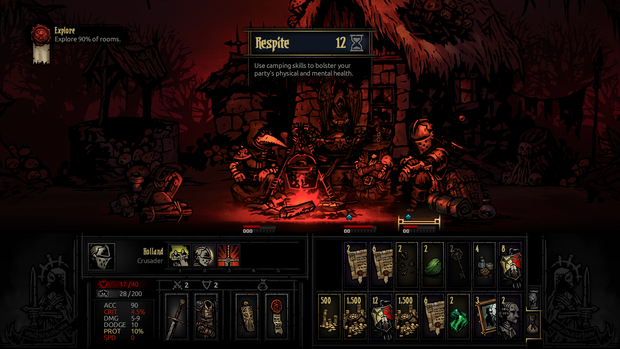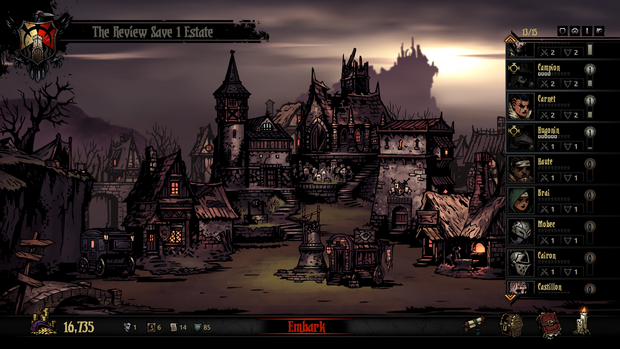It’s entirely possible that by the time you’re reading this, you’ve already played through most of Darkest Dungeon. The game – which was a kickstarter project – has been on Steam’s early access page for some time now. Since its arrival there in early 2015, the game has been continually improved upon. Classes have been added, areas have been unlocked, and the game has only gotten harder.
At its core, Darkest Dungeon is a rogue-like. The idea of the game is to form a party of four travelers, travel through a dungeon level to pick up loot, and gain experience, and do the same thing over again until you beat all the levels. It’s a very rinse, wash, and repeat style of game. That might make it seem boring or repetitive but, that couldn’t be further from the truth. Darkest Dungeon staves off that feeling by infusing the game with a great deal of RPG and system management mechanics.

The RPG mechanics are Darkest Dungeon’s best friend and worst enemy. Each of the characters have a number of stats that range from accuracy, to speed and damage. There are also various resistances to certain diseases and status effects. Items exist in the game that usually have one or two positive effects and a negative one. The problem is that most of these stats aren’t explained in any context and it’s hard to figure out what they do. Even when you do, they’re almost meaningless. A character with a high dodge skill, for example, will still get hit most of the time. A character with high accuracy will probably still miss a great deal of its attacks. After a while you’ll start wondering why the stats even exist.
The variety of characters you get to choose from in Darkest Dungeon make composing your party a personal choice. There are about fourteen different classes, all of which have their own abilities and uses. Because the game is 2D, your party is created in a line of four. But positioning is important. If your character is in the closest slot as opposed to the third slot, they may not be able to use certain abilities. Things like these are what you’ll have to pay attention to when doing battle with the game’s various monsters.
I want to spend a small moment talking about one particular class in the game. The Abomination is probably the game’s most unique. Normally your classes are randomly rolled, and given four of eight abilities. You can unlock the others later, but you can only ever have four equipped. The Abomination is the exception to this rule. He comes with all eight unlocked already, and can use all of them by accessing a transformation he has. He has strong abilities, but causes extra stress on his team when transformed. To add on to this, he also cannot serve on a party with certain classes. It’s an interesting and unique take on a character class that I wish the others had.

The party management aspects of Darkest Dungeon are where it shines the most. The stress mechanic was the big “thing” that Darkest Dungeon hung its hat on and it works out pretty well. Each time you take your four travelers out into a dungeon, they’ll suffer stress from their encounters with the horrors that lurk inside. The most interesting part of the game comes from managing the stress of your heroes, alongside their physical health. Deciding which character interacts with what item and incurs possible stress damage is totally necessary if you wish to survive. If a party member hits their limit, they could go mad – or very rarely – rise to the occasion. But if the stress continues, they’ll die of a stress induced heart attack. In Darkest Dungeon, death is permanent.
Back in the town, there’s more party management to be done. It’s back in town that you can heal the stress damage that your party took during their adventure. You can also upgrade the skills, weapons, and armor of your troops. You can also visit the stagecoach to replenish your army. Your characters have little quirks that affect their stats in battle, or where they can go to relieve their stress. These stats can be cleared from their profile using the Sanitarium, but that takes gold and time.
Darkest Dungeon is a tough game. It is by no means meant to be easy for you. That’s inherent to the genre of rogue-likes. The issue comes early in the game when you’re attempting to learn the mechanics, and even after you have. The game relies on dice rolls for your successes and failures. But more often than not you’ll fail. It definitely seems like the game is meant to weigh the rolls against you. It’s not one of those games where if you lose, it was your fault. Instead if you lose, it was probably because the game felt like it. Following that line of thinking, the game occasionally spawn monsters that are way above the pay grade of the characters you have now. It’s disappointing, but it becomes less of a problem as your characters get stronger.

That is… up to a point. The game places an arbitrary restriction on you where you can’t bring characters that are too high a level into quests meant for lower level characters. I suppose this is meant to prevent grinding for items and gold, but it’s a bit discouraging to never actually feel powerful in the game. Not even for a level or something. The game prefers you take it one inch at a time. I can respect that, because games like Dark Souls are built on the same principal. But even in Dark Souls you’re allowed to go back to earlier areas if you need to with your beefed up character.
A lot of the fun of Darkest Dungeon comes from the art style. It’s got something of a popup book as seen through the lens of H.P. Lovecraft. The monsters are straight out of eldritch horror and some of it is beautifully gross. It’s fun to see the different type of monsters that are represented in each of the zones. There’s little music in the game, but what’s there is meant to ramp up the tension. It’s one of those things that – like the game’s story – is there for framing. The real tension and story come from how you play the game.
Darkest Dungeon is a fun game that relies too much on frustrating dice rolls and arbitrary restrictions to make sure you’re never better than the game. The grind can be fun, and when you’re destroying demons and skeletons out there, it feels like you’re the one in control. But all it takes is one bad roll for everything to go wrong at once. If you can stomach that kind of stress, then Darkest Dungeon could be for you.
